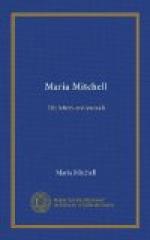“The moon, so white in the sky, becomes densely black when it is closely ranging with the sun, and it shows itself as a black notch on the burning disc when the eclipse begins.
“Each observer made her record in silence, and then we turned and faced one another, with record in hand—we differed more than a second; it was a large difference.
“Between first contact and totality there was more than an hour, and we had little to do but look at the beautiful scenery and watch the slow motion of a few clouds, on a height which was cloud-land to dwellers by the sea.
“Our photographer begged us to keep our positions while he made a picture of us. The only value to the picture is the record that it preserves of the parallelism of the three telescopes. You would say it was stiff and unnatural, did you not know that it was the ordering of Nature herself—they all point to the centre of the solar system.
“As totality approached, all again took their positions. The corona, which is the ‘glory’ seen around the sun, was visible at least thirteen minutes before totality; each of the party took a look at this, and then all was silent, only the count, on and on, of the young woman at the chronometer. When totality came, even that ceased.
“How still it was!
“As the last rays of sunlight disappeared, the corona burst out all around the sun, so intensely bright near the sun that the eye could scarcely bear it; extending less dazzlingly bright around the sun for the space of about half the sun’s diameter, and in some directions sending off streamers for millions of miles.
“It was now quick work. Each observer at the telescopes gave a furtive glance at the un-sunlike sun, moved the dark eye-piece from the instrument, replaced it by a more powerful white glass, and prepared to see all that could be seen in two minutes forty seconds. They must note the shape of the corona, its color, its seeming substance, and they must look all around the sun for the ‘interior planet.’
“There was certainly not the beauty of the eclipse of 1869. Then immense radiations shot out in all directions, and threw themselves over half the sky. In 1869, the rosy prominences were so many, so brilliant, so fantastic, so weirdly changing, that the eye must follow them; now, scarcely a protuberance of color, only a roseate light around the sun as the totality ended. But if streamers and prominences were absent, the corona itself was a great glory. Our special artist, who made the sketch for my party, could not bear the light.
“When the two minutes forty seconds were over, each observer left her instrument, turned in silence from the sun, and wrote down brief notes. Happily, some one broke through all rules of order, and shouted out, ‘The shadow! the shadow!’ And looking toward the southeast we saw the black band of shadow moving from us, a hundred and sixty miles over the plain, and toward the Indian Territory. It was not the flitting of the closer shadow over the hill and dale: it was a picture which the sun threw at our feet of the dignified march of the moon in its orbit.




